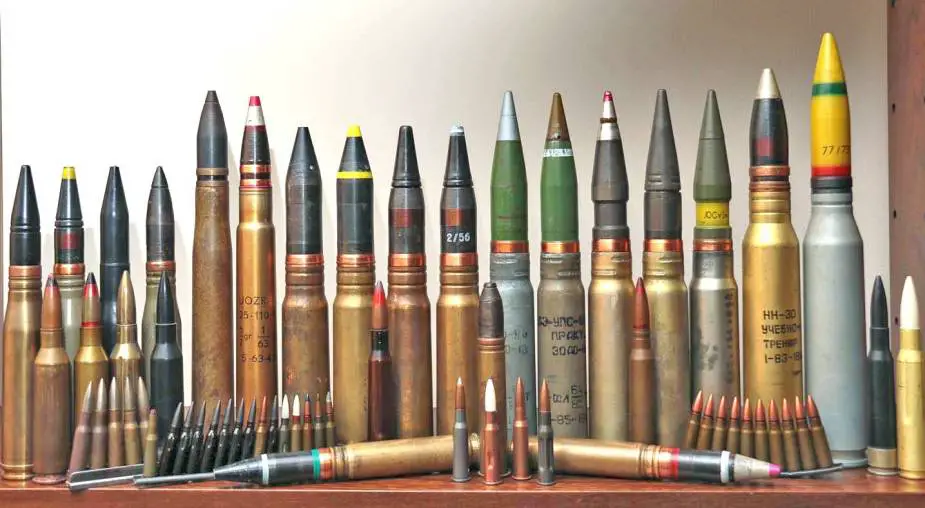Design and production of munitions are priority for Russian armed forces – Part 2
Effective engagement of the payload is the main military-technical task in any conflict of various intensity. It is also necessary to increase the number of munitions and maintain them in the required engagement readiness according to the number of launchers. The might of the Russian armed forces is determined by the latest weapons and hardware and the ability of the defense industry to design and produce modern munitions, PhD Technical Science V. Selivanov, PhD Technical Science V. Veldanov, and PhD Technical Science retired Colonel Yu. Ilyin write in the Voennaya Mysl (Military Thought) journal.
Follow Army Recognition on Google News at this link

Soviet and Russian ammunition up to 30mm (Picture source: Twitter)
At present, Russia and other countries are capable of independently providing their armed forces with everything necessary, including components of various weapons, non-nuclear missile parts, explosives, homing warheads, onboard devices and testing equipment.
The munitions industry is a major part of the military-industrial complex. It ensures security, military-political stability and international prestige of Russia. The industry develops to arm military formations with sufficient weapons for any hostilities. It plays a specific and exclusive role in the national defense and security. It occupies a specific place among defense industries, as its output is the basis for military products in related spheres. Its output is the basis for the production of strategic and tactical missiles, air and seaborne missiles, antitank and air defense weapons, artillery, air, seaborne and engineering munitions, firearms cartridges and shells. The output determines the effectiveness of the engagement of weapons in any combat action.
The munitions industry is science intensive due to the creation of high-power munitions to destroy invulnerable targets, increased jam-resistance of precision munitions, design of high-energy explosive mixtures, gunpowder and solid missile fuel based on achievements in organic and non-organic chemistry, radio electronics, material science, and other spheres of weapon design and introduction; multi-profile and scientific-technical production that includes chemical technologies, solid rocket fuel and gunpowder, arming technologies, precise mechanics, electronic devices for fuzes and guidance on optical electronics and heat vision, laser technologies, specialized ranges with testing equipment for new products, including munitions and their elements, as well as solid-fuel missile engines, utilization of munitions and production diversification.
Special chemistry remains a weak point of the military-industrial complex today, as it has not been financed for many years. In 1988-1989, the industry produced two million tons of explosives only for civilian industries, such as mining. In the middle of the second decade of the 21st century, the volume comprised only 230,000 tons. As a result, the profitability of the industry remains in one of the last places in the military-industrial complex.
The loss-making factors are a high level (over 70 percent) of mobilization capacity due to the disposable use of munitions and a high consumption in combat. The keeping of major stocks in peacetime is economically inappropriate and unsafe.
Russian explosion-hazardous enterprises employ close to 30 thousand people. Emergency situations regularly occur and trigger injuries and loss of life. In the meantime, hundreds of thousands of tons of explosion, fire, and chemically-hazardous products, gunpowder, acids, ammonia, chlorine, and mercury are stored by the enterprises. Expired munitions also pose a major danger in ranges and unequipped utilization sites. Residential quarters are often built in the hazardous areas.
The situation in the munitions industry has begun to radically change of late due to unprecedented NATO enlargement to the Russian borders. A major construction of new ammunition dumps along the Russian western borders was announced. Russia responds to NATO activities by the construction of new arsenals (close to 300) at a safe distance from residential settlements. Munitions will be kept in fire-proof containers that sustain a temperature of 500 degrees for 15 minutes, which is enough for firefighters to arrive. There will be a four-tier system of protective perimeters, including video cameras and motion sensors.
© Copyright 2021 TASS / Army Recognition Group SPRL . All rights reserved. This material may not be published, broadcast, rewritten or redistributed.


























